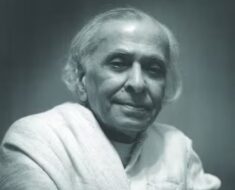Munshi Premchand remains one of India’s most celebrated authors, captivating readers of Hindustani literature for generations. His profound impact on Indian storytelling is undeniable, establishing him as a literary giant.
Wiki/Biography
Dhanpat Rai Shrivastava, later known as Munshi Premchand, was born on Saturday, 31 July 1880, in Lamahi village, Benares State (now Varanasi), British India. His early life was largely spent in Lamahi. At the tender age of seven, he began his education at a madrasa in nearby Lalpur, learning Urdu and Persian.
Tragedy struck when Premchand was eight; his mother, Anandi Devi, passed away. His grandmother subsequently took on his care, but she too died soon after. This left Premchand isolated, with a busy father and a married elder sister. A subsequent family relocation to Gorakhpur and his father’s remarriage resulted in a strained relationship with his stepmother, a recurring theme in much of his later writing.
This challenging childhood, marked by loss and strained family dynamics, led him to find solace in literature. His early fascination with books stemmed from hearing the Persian epic, “Tilism-e-Hoshruba.” This passion eventually led him to work as a bookseller, his first job, where he had extensive access to reading material.
In the mid-1890s, he attended Queen’s College in Benares (now Varanasi). Following his father’s death in 1897, he passed his matriculation exam but financial constraints and a weakness in arithmetic prevented him from continuing at Queen’s College. Though his formal education was interrupted, he later earned a BA degree in English Literature, Persian, and History from Allahabad University in 1919.
Family & Caste
Premchand hailed from a middle-class Kayastha family. His father, Ajaib Rai, worked as a post office clerk, while his mother, Anandi Devi, came from a wealthy family in Karauni village, Uttar Pradesh. Anandi is believed to have been the inspiration for the character “Anandi” in his 1926 novel, “Bade Ghar Ki Beti.”
His grandfather, Guru Sahai Rai, was the village land record-keeper (Patwari). Premchand was the fourth child; his parents also had one other surviving son and two sisters who died in infancy.
Premchand married twice. His first marriage, arranged at age 15, was reportedly unhappy. His second marriage, to a child widow, Shivarani Devi, in 1906, faced strong societal disapproval at the time. After Premchand’s death, Shivarani Devi published “Premchand Ghar Mein,” offering insights into his personal life, including his extramarital affairs. With Shivarani Devi, he had three children: two sons, Amrit Rai (also an author) and Sripath Rai, and a daughter, Kamala Devi.
Signature
Career
As a Teacher
After his matriculation, Premchand briefly served as a tutor before securing a teaching position at a missionary school in Chunar. Subsequent teaching roles included an assistant teacher position at a government school in Bahraich and later at Pratapgarh’s Government Inter College, where he acquired the title “Munshi.”
His career in teaching spanned several locations, including Kanpur, where he served for four years, and Gorakhpur. He left teaching in 1921 to participate in Mahatma Gandhi’s non-cooperation movement. He briefly returned to teaching at Kanpur’s Marwari College in 1931 before resigning due to disagreements with the college administration.
As a Novelist & Story Writer
Premchand’s writing career began early, though his first works were unpublished. His first published novel, “Asrar-e-Ma’abid” (Devasthan Rahasya in Hindi), appeared in 1903. His first published short story, “Duniya Ka Sabse Anmol Ratan,” was published in the Urdu magazine Zamana in 1907. That same year, his short story collection, “Soz-e-Watan,” was banned by the British for being seditious.
During his time in Kanpur, he published widely in Zamana. His first Hindi story, “Saut,” was published in Saraswati magazine in 1915, followed by his first Hindi short story collection, “Sapta Saroj,” in 1917. His breakthrough novel, “Seva Sadan,” initially written in Urdu as “Bazaar-e-Husn,” earned him significant recognition. “Godan,” considered his masterpiece, was his final completed work. “Mangalsootra,” published posthumously, remained incomplete.
| Novel Title | Publication Year |
|---|---|
| Seva Sadan | 1919 |
| Nirmala | 1925 |
| Gaban | 1931 |
| Karmabhoomi | 1932 |
| Godan | 1936 |
His eight-volume collection, Mansarovar (1900-1936), remains extremely popular. His last published story, “Cricket Matching,” appeared in Zamana in 1938, after his death.
As an Editor & Publisher
In 1923, Premchand established the Saraswati Press in Benares, publishing several acclaimed works, including Rangabhumi, Pratigya, Nirmala, and Gaban. He also launched the political weekly magazine “Hans” and, later, “Jagaran,” both of which ultimately faced financial difficulties. He later served as an editor for various magazines, including “Maryada” and “Madhuri.”
As a Script Writer
Premchand briefly worked in the Hindi film industry in Bombay (now Mumbai), writing the script for the 1934 film “Mazdoor.” However, the film was banned due to objections from Bombay’s business class. He found the commercial environment stifling and returned to Benares in 1935, where he remained until his death in 1936.
Notable Works
Novels
- Seva Sadan (1919)
- Nirmala (1925)
- Gaban (1931)
- Karmabhoomi (1932)
- Godan (1936)
Short Stories
- Bade Bhai Sahab (1910)
- Panch Parameshvar (1916)
- Boodhi Kaki (1921)
- Shatranj Ke Khiladi (1924)
- Namak Ka Daroga (1925)
- Poos Ki Raat (1930)
- Idgah (1933)
- Mantra
Writing Style
Premchand’s realistic portrayal of everyday life earned him the title “People’s Writer.” His works explored a wide range of social issues, including the feudal system, child widowhood, poverty, and corruption. His writing incorporated social realism, a stark contrast to the more romanticized styles prevalent at the time.
He championed a literature that served society usefully, advocating for a move away from imitation and toward original, indigenous literary expressions. His writings significantly influenced India’s independence movement, reflecting diverse political perspectives. He often included Muslim characters in his stories, despite being Hindu, highlighting the depth of his understanding of various communities.
Controversies
Premchand faced criticism for his first marriage and subsequent remarriage to a child widow. His personal life, particularly his extramarital affairs as revealed by his second wife, also drew considerable attention and negative commentary. Allegations of fraudulent activities at his press also emerged.
Favourite Things
• Writing Genre: Fiction
• Novelist: George W. M. Reynolds
• Writers: Charles Dickens, Oscar Wilde, John Galsworthy, Sadi, Guy de Maupassant, Maurice Maeterlinck, Hendrik van Loon
• Novel: “The Mysteries of the Court of London” by George W. M. Reynolds
• Philosopher: Swami Vivekananda
• Indian Freedom Fighters: Mahatma Gandhi, Gopal Krishna Gokhale, Bal Gangadhar Tilak
Death
Premchand passed away on Thursday, 8 October 1936, in Varanasi, following a prolonged illness. A memorial stands in his honor in his native village of Lamahi.
Facts/Trivia
• Premchand used the pen names Munshi Premchand and Nawab Rai.
• He was nicknamed “Nawab” by his uncle.
• His first novel, “Asrar-e-Ma’abid,” was written under the pseudonym “Nawab Rai.”
• He acquired the title “Munshi” during his time in Pratapgarh.
• The British government banned his first short story collection, “Soz-e-Watan.”
• Daya Narain Nigam suggested the pseudonym “Premchand.”
• Premchand began writing in Hindi in 1914.
• He had a cameo role in the 1934 film “Mazdoor.”
• He experienced significant financial difficulties at one point.
• He became the first President of the Progressive Writers’ Association before his death.


